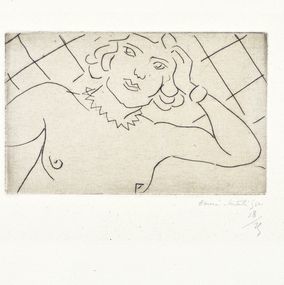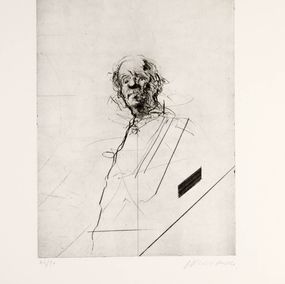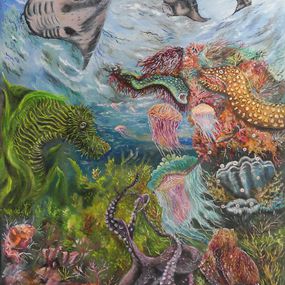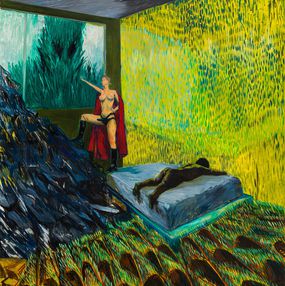
by Henri Matisse
Print : lithography
32 x 51 x 0.2 cm 12.6 x 20.1 x 0.1 inch
Second NOT DISPLAYED BLUR TEXT
Free returns within 14 days
Authenticity guaranteed
Learn moreSecure payment
About the artwork
Type
Unique work
Signature
Hand-signed by artist
Authenticity
Sold with certificate of Authenticity from the gallery
Invoice from the gallery
Medium
Dimensions cm • inch
32 x 51 x 0.2 cm 12.6 x 20.1 x 0.1 inch Height x Width x Depth
Support
Framing
Not framed
Tags
Artwork sold in perfect condition
Artwork location: France
Les Fauves by Henri Matisse (1869-1954), hand-signed book cover lithography printed in 30's in Switzerland, printed by Mourlot Editions
About the seller
galerie bruno massa • France
Artsper seller since 2015
Vetted Seller
This seller rewards your purchases of multiple artworks
Imagine it at home

Discover more by the artist
Works in prints from Henri Matisse
Presentation
Henri Matisse, in full Henri-Émile-Benoît Matisse (born December 31, 1869, Le Cateau, Picardy, France - died November 3, 1954, Nice) is an artist often regarded as the most important French painter of the 20th century. The leader of the Fauvist movement around 1900, Matisse pursued the expressiveness of colour throughout his career. His subjects were largely domestic or figurative, and a distinct Mediterranean verve presides in the treatment.
Matisse, whose parents were in the grain business, displayed little interest in art until he was 20 years old. From 1882 to 1887 he attended the secondary school in Saint-Quentin; after a year of legal studies in Paris, he returned to Saint-Quentin and became a clerk in a law office. He began to sit in on an early-morning drawing class at the local École Quentin-Latour, and, in 1890, while recovering from a severe attack of appendicitis, he began to paint, at first copying the coloured reproductions in a box of oils his mother had given him. In 1891 he abandoned the law and returned to Paris to become a professional artist.
Although at this period he had, in his own words, “hair like Absalom's," he was far from being a typical Left Bank bohemian art student. The 19th-century gospel of work, derived from a middle class, northern French upbringing, was to mark his entire career, and soon it was accompanied by a thoroughly bourgeois appearance—gold-rimmed spectacles; short, carefully trimmed beard; plump, feline body; conservative clothes—which was odd for a leading member of the Parisian avant-garde.
Matisse did not, however, become a member of the avant-garde right away. In 1891, in order to prepare himself for the entrance examination at the official École des Beaux-Arts, he enrolled in the privately run Académie Julian, where the master was the strictly academic William-Adolphe Bouguereau, then at the peak of a since-departed fame as a painter of bevies of naked, mildly provocative nymphs. That Matisseshould have begun his studies in such a school may seem surprising, and he once explained the fact by saying that he was acting on the recommendation of a Saint-Quentin painter of hens and poultry yards. But it must be remembered that he himself was for the moment a provincial with tastes that were old-fashioned in a Paris already familiar with the Post-Impressionism of Paul Cézanne, Paul Gauguin, and Vincent van Gogh. His earliest canvases are in the 17th-century Dutch manner favoured by the French Realists of the 1850s.
In 1892 he left the Académie Julian for evening classes at the École des Arts Décoratifs and for the atelier of the Symbolist painter Gustave Moreau at the École des Beaux-Arts, without being required to take the entrance examination. Matisse continued, with some long interruptions, to study in the atelier until 1899, when he was forced to leave by Fernand Cormon, an intolerant painter who had become the professor after Moreau's death. After that, although he was nearing 30, he frequented for a time a private academy where intermittent instruction was given by the portraitist Eugène Carrière.
In 1896 Matisse exhibited four paintings at the backward-looking Salon de la Société Nationale des Beaux-Arts and scored a triumph; he was elected an associate member of the Salon society, and his Woman Reading (1894) was purchased by the government. From this point onward he became increasingly confident and venturesome, both as an artist and as a man. During the next two years he undertook expeditions to Brittany, met the veteran Impressionist Camille Pissarro, and discovered the series of Impressionist masterpieces in the Gustave Caillebotte Collection, which had just been donated—amid protests from conservatives—to the French nation. His colours became, for a while, lighter in hue and at the same time more intense. In 1897 he took his first major step toward stylistic liberation and created a minor scandal at the Salon with The Dinner Table (La Desserte), in which he combined a Renoir kind of luminosity with a firmly classical composition in deep red and green.
In 1898 he married a young woman from Toulouse, Amélie Parayre, and left Paris for a year, visiting London, where he studied the paintings of J.M.W. Turner, and working in Corsica, where he received a lasting impression of Mediterranean sunlight and colour.He became interested in the Pointillist idea of obtaining additive mixtures of colour on the retina by means of juxtaposed dots (points in French) on the canvas.
He purchased from Vollard the plaster model of the bust of Henri Rochefort by Auguste Rodin, and during 1899 he began to attend an evening class in sculpture. His early work in three dimensions, the first of some 60 pieces he executed during his lifetime, reveals the influence not only of Rodin but also of Antoine-Louis Barye, generally considered the greatest French sculptor of animals.
After 1899 he ceased to exhibit at the Salon and gradually became a familiar figure in the Parisian circles where modern art was being produced and ardently discussed. In 1901 he showed for the first time in the juryless, eclectic Salon des Indépendants, which had been founded in 1884 as a refuge for painters unacceptable to the official exhibition juries. In 1902 he was in a group show at the small gallery of Berthe Weill, and the next year he and a number of his old classmates from Moreau's atelier and the Académie Carrière were the progressive contingent in the liberal, newly created Salon d'Automne. But in spite of such recognition, he was often on the brink of financial disaster. In 1900 he was obliged to accept work on the decoration of the Grand Palais, which was being erected to house part of the new Exposition Universelle in the Champs-Élysées quarter. He was past 34 when, in June 1904, at Vollard's gallery, he had his first one-man show, and it was a failure.
He spent the summer of 1905 with André Derain at Collioure, a small French fishing port on the Mediterranean, near the Spanish border. In the dazzling sunshine he rapidly freed himself from what he called “the tyranny" of Pointillism. The carefully placed little dabs required by the additive-mixture approach turned into swirls and slabs of spontaneous brushwork, and the theoretically realistic colours exploded into an emotional display of complementaries: red against green, orange against blue, and yellow against violet. Representative of this new freedom were Open Window, which was finished at Collioure, and Woman with the Hat, a portrait of his wife painted back in Paris in September. That fall, the two pictures were exhibited at the Salon d'Automne alongside works by a number of artists who also had been experimenting with violent colour. The Paris critic Louis Vauxcelles called the group les fauves (“the wild beasts"), and thus Fauvism, the first of the important “isms" in 20th-century painting, was born. Almost immediately Matisse became its acknowledged leader.
The Stein family in Paris—Gertrude, her brothers Leo and Michael, and the latter's wife, Sarah—became Matisse collectors. In 1906 the artist had a show at the Galerie Druet in Paris in addition to exhibiting again at the Salons des Indépendants and d'Automne. In 1908 he exhibited in New York City, Moscow, and Berlin.
Fauvism was too undisciplined to last long, and soon its adherents were moving, according to their temperaments, toward Expressionism, Cubism, or some kind of neo-traditionalism. Matisse had no liking for these directions, and if “Fauve" is taken to mean simply a painter with a passion for pure colour, he can be said to have remained one all his life. He had, however, too much rationalism in his outlook not to wish for some order in a stylistic situation that threatened to become chaotic, and his search for chromatic equilibrium and linear economy can be followed in a series of major works produced between the revelation of Fauvism in 1905 and the end of World War I. In 1906 he painted Joy of Life; in 1908, The Dessert, a Harmony in Red; in 1911, The Red Studio; in 1915, Goldfish; in 1916, Piano Lesson; and in 1918, Montalban, Large Landscape.
Matisse had been interested in etching, drypoint, lithography, and allied printmaking techniques since his first years in Paris and had produced a number of occasional prints. In 1932 he had published, as illustrations for an edition of Stéphane Mallarmé's Poésies, 29 etchings, in which his talent for supple contours and linear economy was subtly attuned to the “purity of means" evident in the poems. After the outbreak of World War II, he became increasingly active as a graphic artist. He illustrated numerous books and published Jazz (1947), a book consisting of his own reflections on art and life, with brilliantly coloured illustrations made by a technique he called “drawing with scissors": the motifs were pasted together after being cut out of sheets of coloured paper (hand-painted with gouache in order to get the desired hue).
During the last years of his life, he was a rather solitary man who was separated from his wife and whose grownup children were scattered. After 1941, when he underwent an operation for an intestinal disorder, he was bedridden much of the time; after 1950 he suffered from asthma and heart trouble. Often he was obliged to work on his mural-sized projects from a studio bed with the aid of a crayon attached to a long pole. But there are no signs of flagging creative energy or of sadness in his final achievements; on the contrary, these works are among the most daring, most accomplished, and most serenely optimistic of his entire career.
Matisse considered the peak of his life-work to be his design and decoration of the Chapel of the Rosary for the Dominican nuns at Vence, France (1948–1951). He designed the black-and-white tile pictures, stained glass, altar crucifix, and vestments (ceremonial robes). At the time of the consecration (declaration of sacredness) of the Vence chapel, Matisse held a large retrospective exhibition (a look back at the work he created) in the Museum of Modern Art in New York City.
The ultimate step in the art of Matisse was taken in his papiers découpés, abstract cutouts in colored paper, executed in the mid-1940s, for example, the Negro Boxer, Tristesse du roi, and Jazz. The master died on November 3, 1954, in Cimiez, France, near Nice.
More works from galerie bruno massa
This seller offers discount when you purchase multiple artworks!
At Artsper, our mission is to allow you to collect works of art with complete peace of mind. Discover the protections we offer at every stage of your shopping experience.
Buy works from the best galleries
We work in close collaboration with carefully selected art galleries. Each seller on Artsper is carefully examined and approved by our team, thus ensuring compliance with our code of ethics. You therefore have the assurance of purchasing authentic, high-quality works.
Total transparency: you know what you are buying
Before being posted online, all artworks on Artsper are reviewed and validated by our moderation team. You can browse with complete peace of mind, knowing that each piece meets our criteria of excellence.
Personalized support: our experts at your service
Our team of contemporary art experts is available by phone or email to answer all your questions. Whether you want advice on a work or a tailor-made selection to enrich your collection, we are here to support you.
Resell your works with ease
If you have purchased a work on Artsper and wish to resell it, we offer you a dedicated platform to relist it. To find out more, click here.
Make offers with Artsper: negotiate like in a gallery
You have the possibility to propose a price for certain works, just like in a gallery. This feature allows you to initiate discussions and potentially acquire your coins at advantageous prices.
Get help with your negotiations
Our team will negotiate for you and inform you as soon as the best offer is obtained. Do not hesitate to call on our expertise to ensure a transaction at the best price.
Order securely
Artsper satisfaction assurance
We want you to be completely satisfied with your purchase. If the work you receive is not to your liking, you have 14 days to return it free of charge, and you will be refunded in full, whatever the reason.
Secure payment with Artsper partners
All credit card payments are processed by Paybox, the world leader in payment solutions. Thanks to their strict security standards, you can transact with confidence.
Problem Support
In the rare event that an artwork arrives damaged or not as described, we are here to help. Whether for a return, refund, restoration or exchange, our team will support you throughout the process and will ensure that we find the solution best suited to your situation.
Conditions to benefit from Artsper protections:
- Use one of the payment methods available on Artsper for your order.
- Report any problems within one week of receiving the work.
- Provide the required photographic evidence (including the original artwork and packaging).
Artsper guarantees cover the following cases:
- The received work lacks a described characteristic (for example, a signature or frame).
- The artwork has significant differences from its description (e.g. color variation).
- The work is damaged upon receipt.
- The work is lost or damaged by the carrier.
- Delivery is significantly delayed.
With Artsper, you collect with complete peace of mind.
Artsper offers you access to more than 200,000 works of contemporary art from 2,000 partner galleries. Our team of experts carefully selects galleries to guarantee the quality and originality of the works.
You benefit from:
- Works at gallery price
- Return within 14 days, regardless of your location
- Easy resale of the work purchased on Artsper
- Personalized research tools (tailor-made selection and universe)
Our customer service is available for any assistance.
Negotiate the price of a work on Artsper
For certain works, you can use the "offer a price" option under the "acquire this work" button. After submitting your offer and making payment, the gallery can accept or decline the proposal. If you refuse, you will be refunded immediately.
For more information, contact us at [email protected].
Artsper delivers worldwide.
Artsper delivers internationally. Customs fees may apply for works shipped internationally, indicated in the first step of the shopping cart.
You can choose a delivery address different from the billing address. Make sure that a trusted person is present to receive the work if you cannot be there.
Right of withdrawal: return a work on Artsper
You have 14 days from receipt to return the work, without justification or penalties. The price of the work and initial shipping costs will be refunded once the gallery confirms receipt of the work.
Artsper covers the return costs, whether by refund or direct payment. The work must be returned in perfect condition, in its original packaging. To exercise your right of withdrawal, send an email to [email protected].
Have you purchased a painting, sculpture or work on paper?
Find our expert advice for the conservation and promotion of your works in the articles below:
- How do I frame my work?
- What base for my sculpture? li>
- How do I light my work?
- How do I install my work?
Go to your account, in your purchases tab, to benefit from exceptional discounts, negotiate for you with our partners, supervisors, assistants, scouts, etc.



































































